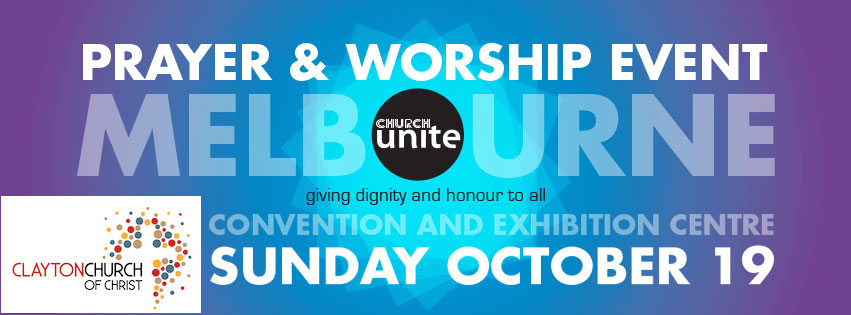On Sunday 19 October a massive event known as Church Unite was held. This article is not just a review of the church services that saw several thousand Christians attend the two services, but also gives consideration to how I feel God and the Holy Spirit has been working in Melbourne of late.
Church Unite saw four of the largest churches across Melbourne come together to organise the event:
The worship team was a collaborative effort, with each church contributing singers, musicians and technical teams of volunteers to each area of logistics. It was mentioned very early during the service itself that some 130+ churches were represented via the 7000+ attendees and registrations received. Each church’s Senior Pastor presented a short segment during the service. At each service the local artist Demain Gibbins painted in real-time two portraits, which were later auctioned off.
 While the 6 pm service was a family-friendly service and the kids were given a dedicated opportunity to pray for families, the 8 pm later session was still popular for people of all age groups, although less crowded. Two key highlights stood out for me from the worship segments during the service – the first was a refreshed lyrics version of the Geoff Bullock song The Great Southland, and the other was a standard rendition of Matt Redman’s 10,000 Reasons/ Bless the Lord.
While the 6 pm service was a family-friendly service and the kids were given a dedicated opportunity to pray for families, the 8 pm later session was still popular for people of all age groups, although less crowded. Two key highlights stood out for me from the worship segments during the service – the first was a refreshed lyrics version of the Geoff Bullock song The Great Southland, and the other was a standard rendition of Matt Redman’s 10,000 Reasons/ Bless the Lord.
The Great Southland (Revised)
The story behind the revision to The Great Southland was sourced here. In summary, the purpose for using this rendition of the song was highly appropriate in aligning to the theme of the evening in acknowledging and giving honour to the Aborigines as natives of Australia. According to the story recorded in the PDF link above, the rewritten lyrics was not a recent event, but transpired in the 1990s during the height of the song’s popularity.
The original lyrics of the verses began “This is our nation, this is our land”, whereas the revised lyrics read “This is Your nation, This is Your land”. This change aligns with the similar revisiting of songs that Geoff Bullock himself did whereby the revised songs focused more so on glorifying God instead of being personal worship songs conveying the feelings of the worshipper. The declaration is loud and clear now – Australia belongs to God. The remainder of the first verse is very much about acknowledging the Aborigines as the first people who had been somewhat forgotten and have their own origin stories relating to the Dream Time.
The chorus remains largely intact and unchanged except for two modifications. Compare the original “And to this sunburnt land we will see a flood” with “And in this sunburnt land we have seen His love”. In the original line, I had always understood the “flood” to mean the futuristic flooding of the Holy Spirit (this context set by the opening chorus line – “This is the Great Southland of the Holy Spirit”). Whilst I do not know, it is my opinion that the removal of “flood”, although done in the 1990s, helped to reduce any controversy which would have caused worshippers to struggle singing that line, particularly given the more regular incidence of flooding across Australia, particularly in the 2000s. The final change in lyrics is the final three words – originally “His Spirit comes” but now “His Spirit’s come.” To help explain this revision, I believe the shorten lyrics, when extrapolated out, becomes “His Spirit has come”. A number of noteworthy comments on this change – the change in tense and subsequent meaning is again to align with a more theologically sound song – acknowledging that God and the Holy Spirit has already come – this is not a future event, whereas the original lyrics made it a present/future event. Naturally, when examined in full we fully appreciate the past tense, but it becomes clumsy when one tries to actually sing it in syncopation and to the song timing and rhythm. Thus, the compromise to ensure it still fits within the timing, the final lyric becomes “His Spirit’s come.” A number of smaller changes are prevalent throughout the other verses. The following table summarises all changes.
[table “” not found /]
10,000 Reasons / Bless The Lord
This worship song and this particular use of it in a church service will stand out to me as being one of the most intense worship moments I have experienced in recent times. Hearing the 1000s of voices raised in glorifying God, blessing His Holy name – both literally as well as figuratively as per the lyrics – was a special moment for me. The energy and passion of God’s church was well and truly ignited in that moment of pure passionate worship.
Now, the song is already a must-have for my list of Top 10 Favourite Worship Songs since 2010 – an article yet to be written. Further, I have already written up a song lyric analysis so all I can really add here is that this song has a particular characteristic that not all worship songs share – the bigger a congregation singing it is the better it becomes. I shall call it the “worship anthem multiplier” effect. Now, you may think that all worship songs share this attribute, and yes that is true – any song when sung by 1000s of voices compared to 100s or 10s will definitely sound better. However, some songs “capitalise” on the effect and stand out more so than others. I make the case that 10,000 Reasons/Bless The Lord is one of those songs. Other examples of songs I believe sharing this worship anthem multiplier effect include:
- How Great Is Our God
- How Great Thou Art
- You Are/You Are Lord
- Worthy is the Lamb (think Michael W Smith concert performance)
- Shout to the Lord
- The Stand
- It is Well (With My Soul)
- Beautiful One
- Christ is Enough
- This I Believe
To a certain extent, these songs are all more corporately oriented in their lyrics, which is why they are more conducive to the multiplier effect. Most of these songs avoid personalising worship whereby use of “I”, “my”, “me” are all avoided. Two exceptions on my list – It Is Well and This I Believe. Each song, potentially from the title alone, honours and glorifies God. It is in this way that the last song – This I Believe – does not get too personal and manages to retain a large corporate worship focus on God the Father, Son and Holy Spirit. The above list is only a small sample of worship songs; it is not intended to be exhaustive, but does give guidance on the kind of effect and experience one can have in a church/corporate worship setting.
God @ Work = Unity in the Spirit
Throughout 2014 I have followed the direction God has led me in serving in various ministries. Certain themes have pervaded the months of service, whereby by involvement across church-specific ministries and events has been intertwined with other circumstances, networks and events operating beyond the local church community. Whilst Engage (Young Adults) has operated in parallel throughout the entire 2014, God made it such that I would not actually be able to serve and support that intra-church ministry. A recent description comparing Engage to Christians 20/30 was that Engage was the smaller Asian variant to the bigger Melbourne-wide network/event ministry. Both are volunteer, not-for-profit Christians organisations that network and bring young people together across churches. The Asian tag for Engage is in part because the seven sponsoring churches are all recognised for their reach to the South-East Melbourne Christian community, listed in alphabetical order:
- Australia for Christ Church
- Clayton Church of Christ
- Full Gospel Assembly (FGA) Melbourne
- New Life Evangelical Church
- Life Expeditions
- Life Gate Church of Christ
- Life Spring Nunawading (3CV)
Whilst I have and support the philosophy of Engage, it remains a future/2015 ambition to see the two organisations of Christians 20/30 team up and work more closely with Engage. The charter of both is in essence the same – bringing people together to build up the church. It was interesting to observe the differing approaches taken – whilst Engage planned almost monthly social events, Christians 20/30 stuck to three/quarterly major events. Engage events were generally held in South East suburban Melbourne whereas Christians 20/30 events were always city/centrally located, reflecting the geography balance and reach of the two organisations in relation to their target audiences. Christians 20/30 is not affiliated by any specific church, although the group draws upon talent and attendees from all the major churches, similar in outreach to Church Unite:
- Bayside Church
- Bridge Church Melbourne
- CityLife Church
- City on a Hill
- Clayton Church of Christ
- Crossway Baptist Church
As part of planning the two final events of 2014 – the Charity Ball and then the Music Festival – there was a strong drive to promote unity across the churches. The vision for Christians 20/30 over 2014 was to build upon our launch back in 2013 and consolidate our presence as an intra-church organisation, supporting and networking young adult believers. When Church Unite was announced in July/August, I immediately recognised the same theme of unity. In one sense, I saw the potential to grow and promote both the Music Festival and Church Unite in the same conversation/theme of church unity. The cross promotional potential was utilised in some of the marketing messages we placed on Facebook.
The theme of church unity has further been enhanced by things like the release of This I Believe, the powerfully and God-anointed song which brings the catholic (universal) church together in worship, declaring the Apostle’s Creed over Christ’s church. Coupled with the latest outreach and missional drive that my church is embarking upon, this theme from 2014 flows on naturally into God’s plan for 2015.


1 comment
Comments are closed.